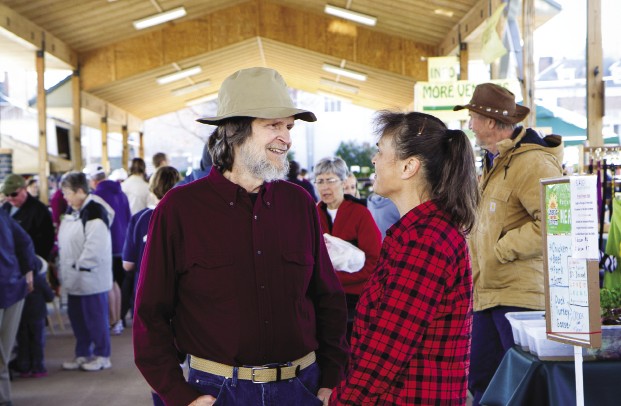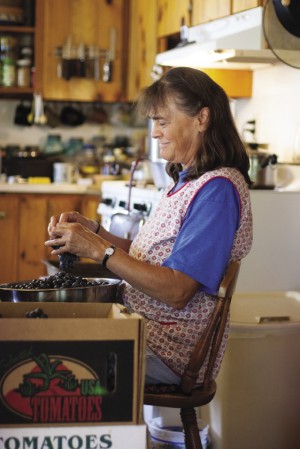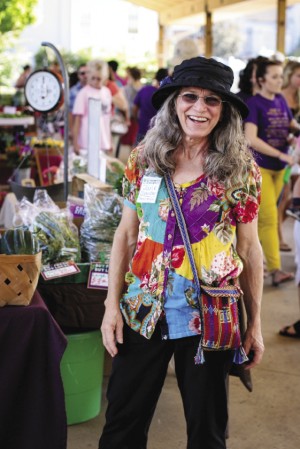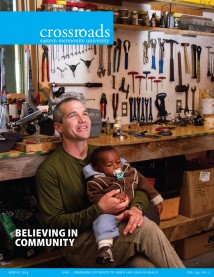
Samuel Johnson, class of 1975, and his wife Margaret Wenger Johnson ’69 were the first farmers to sell their produce in downtown Harrisonburg for an entire growing season. They went on to lobby for a farmers market and see their dream come to fruition. (Photo by Jon Styer)
Margaret Wenger Johnson ’69 held out a mason jar of grape juice. “It’s rich,” Samuel Johnson (class of ’75) said. Margaret nodded and smiled, like they’d discovered it bubbling from the ground — instead of steaming in a steel vat.
The Concord grapes that she had methodically de-stemmed with Marjorie Nafziger ’74, MA ’97 (counseling), grew on vines handed down from Margaret’s father, Chester Wenger ’41. “And his dad grew grapes, and his granddad grew grapes,” she said. “So Samuel and I planted grape vines at the very beginning of our time here.”
That was in 1978. They planted blueberries, broccoli, cabbage, cauliflower and tomatoes – but had nowhere to sell their produce locally. So they dreamed of a farmers market.
As Samuel weighed kale and talked to customers, Radell Schrock ’01 sold his last winter carrots of the day. He joins up to 70 other vendors to sell produce and crafts at the Farmers Market each Tuesday and Saturday morning, made possible by the Johnsons’ vision 35 years ago.
Schrock graduated from EMU with a major in biology and minor in secondary education, then taught at Eastern Mennonite High School for four years. He kept a garden at home, and what began as an idea for a way to make some summer income evolved into a vision of supporting himself with his hands.
Schrock, from Wisconsin, hungered to work more with the soil, but wasn’t sure how to make a living in Valley agriculture. “It’s difficult to move to an area and try to sell piece by piece,” he said. Helped by his connections with around 400 students and their families from his years of teaching, he was able to transition to full-time farming and community supported agriculture. A half-dozen years later, he still sees many of them at the market every week.

Margaret Johnson ’69 processes home-grown grapes in the Johnsons’ home kitchen. (Photo by Samantha Cole)
The Johnsons brought their idea for a farmers market to the Downtown Harrisonburg Retail Merchants in 1978. The following year, they were one of four sets of farmers selling in the Liberty Street parking deck
They were the only ones to continue selling at the market site for the whole summer season, but weren’t deterred. “We were young and strong then, and our dreams were driving us,” Margaret said.
The Harrisonburg Farmers Market Association was incorporated in 1994.
Shortly after, Kris Shank-Zehr ’92 noticed the vendors in the deck on her way to work – a part of downtown she hadn’t been aware of while she was a student. She started buying a few vegetables each week, and then eventually wrote seasonal recipes for the market’s weekly newsletter.
In 2006, the market migrated from the parking deck to the municipal lot on South Liberty Street, until the construction of Turner Pavilion in 2008. Students, visitors and locals pass through the modern-day market to pick up the week’s groceries or just socialize.
Part of the market experience is unplanned conversations while shopping for items her family will eat that week, Shank-Zehr said, unlike the supermarket where customers tend to get in and get out as quickly as possible.
The market has become “Harrisonburg’s premier social event,” Samuel said, laughing. “There’s a lot of visiting and networking, people meeting old acquaintances and making new ones in between their market transactions.” The Johnsons still see customers they served 35 years ago.
Looking back to those first days, they reflected on why they chose this vocation, given the admittedly low pay and hard work.
In college, Samuel was an avid gardener and enamored with Chester Wenger’s vineyard – and Wenger’s daughter – but didn’t know what direction to take after graduation.
“I had been in the Army,” Samuel said: Thailand, during the Vietnam War, despite having applied for conscientious objector status. He struggled with that. “As I was leaving the Army, I had resolved that I was going to commit the rest of my life to peace and not contribute to materialism and violence.”

Josie Showalter is the current manager of the Farmers Market, which has grown to nearly 70 vendors on Tuesday and Saturday mornings, plus musical performers and much socializing. (Photo by Samantha Cole)
Farming, they decided together, would be their part in “contributing to life” while raising a family. They bought some land in Keezletown in October 1978 and built a home. Margaret, having finished a master’s degree in early childhood education at James Madison in 1975, began her own nursery school to supplement the farm income. Today she teaches at Cub Run Elementary School.
“We had very little money, but we both decided we would rather live with that uncertainty and do what we really wanted to do,” she said. In the ’70s and early ’ 80s, emphasis on local, organic food hadn’t made it to Rockingham County yet: they needed to be their own advocates.
Market Manager Josie Showalter says the Johnsons’ commitment, creativity and willingness to collaborate with others brought their dream to reality. This was despite competition from area supermarkets, which are able to buy factory-farmed items wholesale and undercut the prices local farmers must charge to survive. At the Farmers Market, consumers get to meet the people growing their food and talk to them about their production methods, creating community and fostering everyone’s health.
— Samantha Cole ’11
